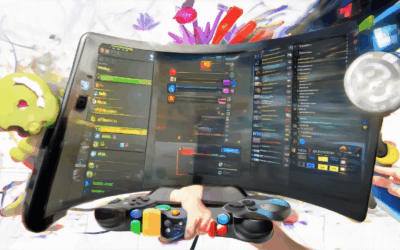Mastering Game Audio Tips: Top Soundtrack Insights for Thriving in Gaming
Engaging with top-tier video game soundtracks and mastering the art of game audio can elevate your gaming experience to new heights. Whether you’re a casual player or a hardcore enthusiast, the role of sound effects and music in enhancing immersion and engagement cannot be overstated. This comprehensive guide delves into the essential strategies and insights needed to thrive in the world of game audio, covering everything from selecting the best audio formats to discovering the greatest video game soundtracks.

How to Have Better Audio in Games
To enhance your gaming audio experience, follow these organized steps:
- Optimize Hardware Setup:
- Use a Quality Headset: Invest in a headset with good noise cancellation and clear microphone quality. USB headsets often perform better than Bluetooth options due to reduced latency and improved signal strength.
-
Equalize Settings: Adjust the EQ settings on your headset to tailor the sound to your preferences. Common recommendations include boosting bass for impactful sounds and treble for clearer highs.
-
Adjust Game Software Settings:
- Background Music: Lower the in-game music volume to better hear game sounds and effects.
-
Stereo Balance: Configure the stereo setting to maximize spatial audio, making sounds feel more immersive.
-
Choose the Right Music:
- Game-Friendly Tracks: Opt for dynamic playlists or curated tracks designed for gaming to maintain focus and energy levels.
-
Personalized Playlists: Mix your own music to match the game’s mood, though be mindful of battery consumption on mobile devices.
-
Manage Environmental Factors:
-
Quiet Environment: Play in a room with minimal distractions and echo. Use acoustic treatments or software to reduce unwanted noises.
-
Regular Firmware Updates:
- Periodically check for updates to your audio device to benefit from performance improvements and bug fixes.
By implementing these strategies, you can elevate your gaming audio experience, ensuring clarity, immersion, and engagement.
Is Game Audio a Good Career?
Yes, game audio can be a highly rewarding and fulfilling career path. As a sound designer or audio engineer in the gaming industry, you play a crucial role in bringing immersive experiences to life through sound effects, background music, and voice acting.
- Creative Freedom: Sound designers have the opportunity to craft unique auditory experiences that enhance gameplay and storytelling. Whether it’s the clatter of swords in an RPG or the hum of a spaceship in a sci-fi game, your creativity shapes the atmosphere.
- Diverse Opportunities: Game audio professionals work across various genres, including AAA blockbusters, indie titles, mobile games, and VR/AR experiences. This diversity allows you to specialize in different areas or explore multiple genres.
- Technical Challenges: Working with audio requires technical expertise in tools like Wwise, FMOD, or Unity. Mastering these platforms enhances your ability to create high-quality sounds and integrate them seamlessly into games.
- Growing Industry: With the increasing popularity of gaming and interactive media, demand for skilled audio professionals has grown. This trend provides stable career prospects and opportunities for growth.
- Collaborative Environment: Sound designers often collaborate with game developers, composers, and voice actors. These collaborations can lead to exciting projects and creative partnerships.
If you’re passionate about creating impactful soundscapes and want to contribute to the world of gaming, pursuing a career in game audio is a decision worth considering. It offers a blend of artistry and technology that few other fields can match.
For more resources and insights into indie game development, visit Indie Dev Games .

Best Audio Format for Games
Choosing the right audio format for your game involves balancing quality, file size, and compatibility. Here’s a breakdown of the best options:
- High-Quality Formats: For immersive, high-dynamic soundtracks, use WAV or FLAC. These uncompressed formats provide crystal-clear audio, ideal for cinematic or realistic experiences.
- Lightweight Formats: For retro or pixelated games, MP3 or OGG are perfect. They offer a nostalgic feel with manageable file sizes, ensuring quick load times and minimal storage usage.
- Compression Balance: OGG is a great middle ground—it compresses audio effectively without sacrificing quality, making it suitable for games requiring larger audio libraries.
- Platform Compatibility: Check your game engine or target platform requirements. Some environments may prefer specific formats like OGG over WAV for better performance.
- Hybrid Approach: Combine formats for diverse soundscapes. Use WAV for detailed orchestras and OGG for ambient sounds, optimizing each part for its intended purpose.
- Device Considerations: Test across various hardware to ensure compatibility. Some devices may struggle with certain formats, so choose wisely based on your audience.

What Are the Three Basic Audio Elements Used in Games?
The creation of an immersive and engaging gaming experience relies heavily on effective sound design, which incorporates three primary audio elements: ambient sounds, sound effects, and music composition. These elements work together to enhance gameplay, set the mood, and provide essential feedback to players.
Ambient Sounds
Ambient sounds are the background noises that create the overall atmosphere of the game. These sounds are often subtle but play a crucial role in immersing players in the game world. Examples include:- Nature Sounds: The rustling of leaves, flowing water, or wind.- Urban Sounds: Car horns, city noise, or crowd chatter.- Fantasy Sounds: Magic effects, mystical ambiance, or alien environments.
Ambient sounds help players feel like they are truly in the game world, whether it’s the quiet of a dark forest or the bustling streets of a busy city.
Sound Effects
Sound effects are the individual auditory cues that correspond to actions, events, or interactions within the game. These effects are immediate and provide critical feedback to players about their actions. Examples include:- Player Movement: Footsteps, running, or jumping sounds.- Collision Sounds: Crashes, explosions, or impacts.- Interface Sounds: Button clicks, menu navigations, or weapon reloads.
Sound effects are essential for conveying game mechanics and providing tactile feedback, making games feel more responsive and dynamic.
Music Composition
Music serves as the emotional backbone of a game, influencing the player’s mood and providing narrative context. Game music can be as simple as a few notes or as complex as an orchestral score, depending on the game’s style. Examples include:- Game Themes: The main theme that plays during the title screen or levels.- Level Variations: Different tracks for different areas or challenges.- Dynamic Music: Music that adapts based on the player’s actions or progress.
Music helps establish a connection between players and the game, evoking emotions and reinforcing the game’s tone.
The Impact of These Elements
When combined effectively, these audio elements create a cohesive soundscape that enhances the player’s experience. Good sound design can make games feel more alive, help players navigate the world, and immerse them in the story.
For game developers looking to improve their sound design skills, resources like Indie Dev Games offer valuable tutorials, reviews, and tips tailored for independent developers. Explore their website to discover tools and insights that can elevate your game’s audio design.
By leveraging ambient sounds, sound effects, and music composition, developers can create gaming experiences that resonate with players on a deeper level.
What Does SFX Stand For?
SFX stands for Special Effects.
- In Film and Video Editing: Special Effects are used to enhance visual quality, add dramatic elements, or create unrealistic scenarios.
- In Gaming: Special Effects are employed to immerse players in virtual worlds, create stunning visuals, and enhance gameplay experiences.
- In Photography: Special Effects refer to techniques used to modify images, such as adding filters, adjusting lighting, or creating artistic alterations.
- In Theater and Live Events: Special Effects are applied to create captivating stage displays, illusions, and audience interactions.
- In Software Applications: Special Effects are integrated to provide users with enhanced user interfaces and interactive experiences.
- In Marketing Campaigns: Special Effects are utilized to create attention-grabbing visuals and memorable brand messages.
- In Virtual Reality: Special Effects play a crucial role in creating realistic and immersive environments.
- In Education and Training: Special Effects are used to develop engaging educational simulations and demonstrations.
- In Advertising: Special Effects help businesses create visually striking advertisements that capture consumer attention.
- In Healthcare: Special Effects are applied in medical training simulations and patient care demonstrations.
- In Architecture: Special Effects are used to visualize complex building designs and structures.

What Are the Three Levels of Audio?
There are three primary levels of audio quality, each catering to different environments and requirements:
1.
High-Level Audio
- High-level audio refers to professional-grade sound production, often found in recording studios, live performances, or high-end home theater systems.
- This level typically features crystal-clear sound quality, rich bass frequencies, and immersive spatial audio effects.
- Equipment used includes high-end microphones, premium speakers, and advanced mixing consoles.
2.
Medium-Level Audio
- Medium-level audio is commonly found in consumer electronics, such as smartphones, tablets, and compact speaker systems.
- While it may lack the precision of high-level audio, it still provides sufficient sound quality for everyday listening.
- Examples include music played through headphones or soundbars in living rooms.
3.
Low-Level Audio
- Low-level audio is often associated with poor sound quality, such as muffled speech or distorted music.
- This can result from outdated equipment, insufficient amplification, or background noise interference.
- Common scenarios include hearing low-quality audio in public spaces or via poorly maintained devices.
Conclusion
Understanding these audio levels helps individuals choose the right equipment and environments for their needs, whether they are a casual listener or a professional creator.




0 Comments